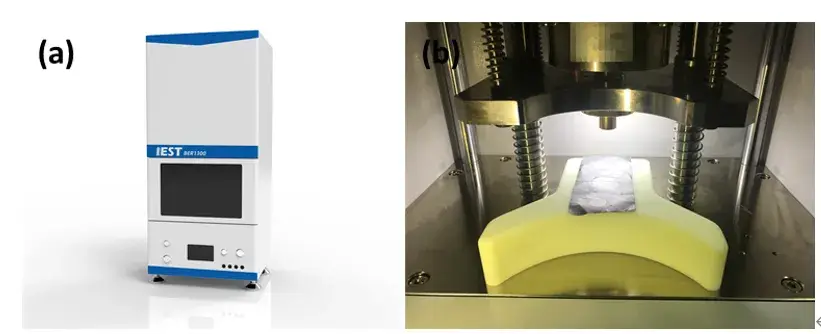-
iestinstrument
Carbon-coated Aluminum Foil Resistance Performance Evaluation
1. Preface
As a carrier for conducting electrons and carrying active materials inside the lithium-ion battery, the collector plays an important role in the final performance of the battery cell. Aluminum foil is the most commonly used anode electrode collector. In order to improve the multiplication rate, cycle and service life of the electrode, some conductive coatings are applied on the surface of the aluminum foil, which can effectively improve the interfacial contact resistance between the collector and the active particles and improve the bonding strength of the active substance and the collector, and reduce the problem of active particles peeling off in the process of electrode cycling. The coating of carbon-coated aluminum foil(also seen as carbon coated al foil or nano-carbon coated aluminium foil) generally usually includes conductive carbon black, graphene, carbon nanotubes, etc. The formulation of the carbon coated layer, the thickness of the coating, the coating uniformity, etc. will also affect the effect of the bottom coating ¹.
In this paper, the resistance difference of carbon-coated aluminum foils with different formulations and different coating thicknesses is compared by using the electrode resistance test method to analyze the uniformity of their undercoated electrodes.

Figure. 1. Schematic diagram of the effect of carbon coated collectors on cell performance¹
2. Experimental Equipment & Test Method
2.1 Experimental instrument
Battery Electrode Resistance Tester BER1300 (IEST).
-
Electrode diameter: 14 mm
-
Pressure range: 5–60 MPa
-
Software: MRMS for automated reading of thickness, resistance, resistivity and conductivity
Figure 2. (a) BER1300 appearance; (b) BER1300 structure
2.2 Samples to be tested
-
Bare aluminum foil (10 µm)
-
Two carbon-coated aluminum foils with coating thicknesses of 4 µm and 7 µm
-
Three primer formulations for the carbon layer
-
Electrodes after coating with active materials
2.3 Test method
Cut the sample of electrode sheet to be tested into a rectangular size of about 5cm×10cm, place it on the sample stage, set the parameters of test pressure and holding time on MRMS software, and start the test, and the software automatically reads the thickness of the electrode sheet, electrical resistance, resistivity, conductivity and other data.
3. Results & Data Analysis
Different formulations of charcoal-coated aluminum foil are tested, the thickness of empty aluminum foil is 10 μm, and the thickness of the two charcoal-coated layers is 7 μm and 4 μm, respectively, and the resistance of the tested poles is shown in Fig. 3(a) and (b), which reveals that the resistances of different formulations of carbon-coated aluminum foils vary greatly from tens of mΩ to tens of Ω, and the uniformity of the resistances of different processes of carbon-coated aluminum foils are also very different from that of the different positions in a single electrode, such as 4 μm-R(Ω)-1 and 7 μm-R(Ω)-1. There is also a big difference, such as 4μm-R(Ω)-1 and 7μm-R(Ω)-1, the resistance box plot of these two carbon-coated aluminum foils is wider, which indicates that the uniformity of resistance at different positions is poor, which is related to the coating is too thin, there may be leakage of the coating or uneven distribution of carbon material¹.
Analysis of the data in Figure. 3(c) shows that the conductivity of the empty aluminum foil is the best, and when the carbon coated layer and the active material are added, the resistivities of the electrode sheets tested using the two-probe principle all gradually increase, which indicates that the addition of the coating introduces contact resistance between the particles, making the conductivity of the electrons weaker. Although it is generally believed that the conductivity of the electrodes is enhanced by the addition of a carbon coating layer on the surface of the aluminum foil, which is mainly due to the fact that the charcoal coating layer increases the surface roughness of the aluminum foil, which results in a better contact between the particles of the active material and the collector, the conductivity uniformity of the electrodes coated with the active material can also be affected if the thickness of the coating is thicker or the uniformity of the coating is too poor.



Figure. 3. (a) Resistance of foil with 4μm thickness of carbon coating layer. (b) Resistance of foil with 4 μm thickness of carbon coating layer. (c) Electrode resistivity in three different states

Figure. 4. Schematic representation of the surface morphology of black carbon-coated aluminum foil¹
In summary, the addition of an effective intermediate layer between the active material and the metal collector serves to improve the interfacial contact resistance in addition to the following potential synergistic benefits:
(1) the chemically and electrochemically stable conductive layer can act as an effective diffusion barrier to prevent the diffusion of oxygen generated by side reactions due to electrolyte decomposition and/or lithium ion embedding reaction processes, effectively preventing the formation of an oxidized layer on the surface of the metal collector, and thus preventing degradation;.
(2) The reasonably formulated conductive layer has good electrical conductivity, which allows for the formation of a large area of contact and a low interfacial resistance between the collector and the active coating, thereby facilitating a rapid charge transfer process;
(3) The flexibility and mechanical cushioning of the conductive layer enhances the adhesion at the physical interface, thereby minimizing the problems associated with the gradual loss of contact area caused by the stresses generated at the interface during the long-term cyclic reaction process. Through the design and development of unique conductive coatings, it has been experimentally demonstrated that the conductive interfacial layer can significantly improve electrochemical properties, such as specific reversible capacity, capacity retention, and multiplicity performance.
4. Recommendations for Manufacturing & R&D
To maximize the advantages of carbon-coated collectors while avoiding conductivity pitfalls:
-
Optimize formulation: Balance conductive filler type (carbon black, graphene, CNTs) and binder to obtain high surface conductivity and mechanical integrity without creating agglomerates.
-
Control thickness precisely: Target thickness windows that provide surface roughness and protection but avoid excessive coating that increases inter-particle resistance.
-
Ensure coating uniformity: Use inline metrology (thickness mapping, resistivity mapping) and implement process controls to detect and correct coating non-uniformity.
-
Characterize by position: Perform spatial resistance mapping (boxplots per location) rather than relying solely on average values; local hotspots often determine failure modes.
-
Test with active material: Include the final electrode stack (foil + active coating) in qualification tests because the added layer changes macroscopic resistivity.
-
Iterate with electrochemical testing: Combine physical resistance measurements with electrochemical cycle testing to correlate coating metrics with capacity retention, rate performance, and long-term cycling stability.
5. Summary
Carbon-coated aluminum foil is increasingly adopted as a positive electrode collector due to its capacity to improve interfacial contact, adhesion, and protection of the Al substrate. However, the benefits depend critically on formulation, coating thickness, and—most importantly—coating uniformity. Electrode resistance testing (e.g., BER1300) is an effective QC tool to compare formulations and processes. By optimizing carbon type, dispersion, and coating controls, manufacturers can harness the advantages of carbon-coated aluminum foil (and variants such as nano-carbon coated aluminium foil or carbon coated al foil) to help lithium R&D personnel to monitor the stability of the primer coating process.
6. References
[1] Busson, C, Blin, M.A., Guichard, P., Soudan, P., Crosnier, O., Guyomard, D., & Lestriez, B. (2018). A primed current collector for high performance carbon-coated LiFePO4 electrodes with no carbon additive. Journal of Power Sources, 406, 7-17.
[2] Chen Peng, Ren Ning, Ji Xuemin, et al. Investigation on Graphite/LiFePO4 Batteries Fabircated by Carbon-Coated Aluminum Foil Current Collector [J]. New Energy Progress, 2017, 5(2): 157-162.
[3] Li Min, et al.Effect of carbon-coated Al foil on properties of lithium iron phosphate batteries[J]. Energy Storage Science and Technology, 2020, 9(6), 1714-1719.
Contact Us
If you are interested in our products and want to know more details, please leave a message here, we will reply you as soon as we can.



